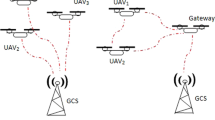Abstract
The paper presents a novel algorithmic approach that allows to tackle in a common framework the problems of area decomposition, partition and coverage for multiple heterogeneous Unmanned Aircraft Systems (UAS). The approach combines computational geometry techniques and graph search algorithms in a multi-UAS context. Even though literature provides several strategies for area decomposition like grid overlay decomposition or exact cellular methods, some fail to either successfully decompose complex areas, or the associated path generation strategies are not feasible. The proposed approach manages to perform an exact cellular decomposition of non-convex polygonal coastal areas and includes an attributes based schema for area partitioning. In particular, the proposed solution uses a Constrained Delaunay Triangulation (CDT) for computing a configuration space of a complex area containing obstacles. The cell size of each produced triangle is constrained to the maximum projected Field-of-View (FoV) of the sensor on-board each UAS. In addition, the resulting mesh is considered as an undirected graph, where each vertex has several attributes used for area partitioning and coverage in a multi-UAS context. Simulation results show how the algorithms can compute sound solutions in real complex coastal regions.
Similar content being viewed by others
References
Galceran, E., Carreras, M.: A survey on coverage path planning for robotics. Robot Auton Syst 61(12), 1258–1276 (2013)
Zheng, X., Koenig, S., Kempe, D., Jain, S.: Multirobot forest coverage for weighted and unweighted terrain. IEEE Trans Robot 26(6), 1018–1031 (2010)
Choset, H., Pignon, P.: Coverage path planning : the boustrophedon cellular decomposition. Auton Robot 9(3), 247–253 (1997)
Janchiv, A., Batsaikhan, D., Kim, B., Lee, W.G., Lee, S.-G.: Time-efficient and complete coverage path planning based on flow networks for multi-robots. Int J Control Autom Syst 11(2), 369–376 (2013)
Ranjbar-Sahraei, B., Weiss, G., Nakisaee, A.: A Multi-robot Coverage Approach Based on Stigmergic Communication, pp. 126–138. Berlin, Heidelberg (2012)
Saldaña, D., Chaimowicz, L., Campos, M.F.M.: Searching for regions out of normal conditions using a team of robots, pp. 1–15. Springer, Berlin (2015)
Fazli, P., Davoodi, A., Mackworth, A.K.: Multi-robot repeated area coverage. Auton Robot 34(4), 251–276 (2013)
Valente, J., Del Cerro, J., Barrientos, A., Sanz, D.: Aerial coverage optimization in precision agriculture management: a musical harmony inspired approach. Comput Electron Agric 99, 153–159 (2013)
Sadat, S.A., Wawerla, J., Vaughan, R.: Fractal trajectories for online non-uniform aerial coverage, pp. 2971–2976 (2015)
Li, Y., Chen, H., Joo Er, M., Wang, X.: Coverage path planning for UAVs based on enhanced exact cellular decomposition method. Mechatronics 21(5), 876–885 (2011)
Maza, I., Ollero, A.: Multiple UAV cooperative searching operation using polygon area decomposition and efficient coverage algorithms, volume 6 of Distributed Autonomous Robotic Systems, pp. 221–230. Springer (2007)
Daisuke, K., Ota, J., Arai, T., Yoshida, E.: An algorithm of dividing a work area to multiple mobile robots. In: Proceedings IEEE/RSJ international conference on intelligent robots and systems 95.’Human robot interaction and cooperative robots’, vol 2, pp. 286–291. IEEE (1995)
Acar, E.U., Choset, H., Rizzi, A.A., Atkar, P.N., Hull, D.: Morse decompositions for coverage tasks. Int J Robot Res 21(4), 331–344 (2002)
Berger, J., Lo, N.: An innovative multi-agent search-and-rescue path planning approach. Comput Oper Res 53, 24–31 (2015)
Jarvis, R., Byrne, J.C.: Robot navigation: Touching, seeing and knowing. In: Proceedings of the 1st Australian conference on artificial intelligence (1986)
Kurabayashi, D., Ota, J., Arai, T., Yoshida, E.: Cooperative sweeping by multiple mobile robots. In: Proceedings of IEEE international conference on robotics and automation, 1996. vol 2, pp. 1744?-1749. IEEE (1996)
Balampanis, F., Maza, I., Ollero, A.: Area decomposition, partition and coverage with multiple remotely piloted aircraft systems operating in coastal regions. In: International Conference On Unmanned Aircraft Systems (ICUAS), number 642153, pp. 275–283. IEEE (2016)
Boissonnat, J.-D., Devillers, O., Pion, S., Teillaud, M., Yvinec, M.: Triangulations in CGAL. Comput. Geom. 22(1–3), 5–19 (2002)
Kallmann, M., Bieri, H., Thalmann, D.: Fully dynamic constrained delaunay triangulations. Geometric Modelling for Scientific Visualization 241–257 (2003)
Cgal - 2d conforming triangulations and meshes - 2.5 optimization of meshes with lloyd. http://doc.cgal.org/latest/Mesh_2/index.html#secMesh_2_optimization (2016)
Tournois, J., Alliez, P., Devillers, O.: 2D centroidal Voronoi tessellations with constraints. Numer Math 3(2), 212–222 (2010)
The CGAL Project: CGAL User and Reference Manual. CGAL Editorial Board, 4.8.1 edition (2015)
Quigley, M., Conley, K., Gerkey, B.P., Faust, J., Foote, T., Leibs, J., Wheeler, R., Ng, A.Y.: ROS: an open-source robot operating system. In: ICRA workshop on open source software (2009)
Autopilot software in the loop simulation. http://ardupilot.org/dev/docs/sitl-simulator-software-in-the-loop.html (2016)
Rviz – 3d visualization tool for ros. http://wiki.ros.org/rviz (2016)
Mavros – mavlink extendable communication node for ros with proxy for ground control station. http://wiki.ros.org/mavros (2016)
Fixed wing ardupilot instance for autopilot hardware. http://ardupilot.org/plane/index.html (2016)
Jsbsim, the open source flight dynamics model in c++. http://jsbsim.sourceforge.net/ (2016)
Qgroundcontrol - ground control station for small air - land - water autonomous unmanned systems. http://qgroundcontrol.org/ (2016)
Meier, L., Honegger, D., Pollefeys, M.: PX4: A node-based multithreaded open source robotics framework for deeply embedded platforms. In: 2015 IEEE international conference on robotics and automation (ICRA) (2015)
Author information
Authors and Affiliations
Corresponding author
Additional information
This work is partially supported by the MarineUAS Project funded by the European Union’s Horizon 2020 research and innovation programme, under the Marie Sklodowska-Curie grant agreement No 642153 and the AEROMAIN DPI2014-C2-1-R Spanish project.
Rights and permissions
About this article
Cite this article
Balampanis, F., Maza, I. & Ollero, A. Area Partition for Coastal Regions with Multiple UAS. J Intell Robot Syst 88, 751–766 (2017). https://doi.org/10.1007/s10846-017-0559-9
Received:
Accepted:
Published:
Issue Date:
DOI: https://doi.org/10.1007/s10846-017-0559-9




